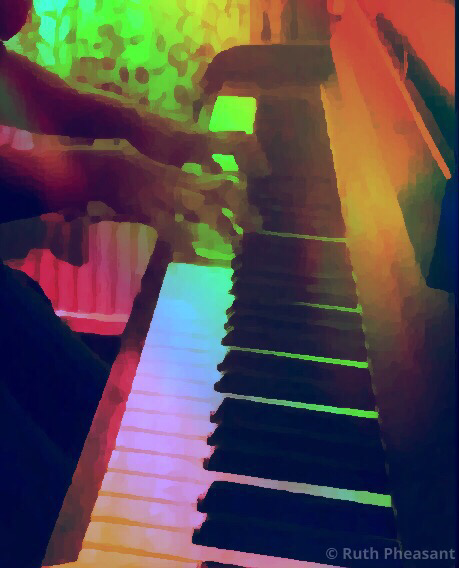Explaining Degrees of the Scale, Tonic Triads and Inversions
In this tutorial I am going to show you how to figure out the most basic chords of any key, on the piano. Once you know the basics you can then experiment with more complicated chords and interesting chord combinations. This can be useful for improvisation, composition and understanding music theory. A better understanding of chords and how they are structured also helps you to recognise them and their variations in pieces of music you are learning to play, and thus more easily memorise the music.
To create a chord in any particular key, it helps to know the scale of that key. The easiest example on the piano is a C major scale, as it is all white keys. The picture below shows one octave (eight notes) of a C major scale:
The blue dots show the white keys you have to play for a C major scale. Underneath are the letter names of the notes you play. These notes in this particular order are known as the degrees of the scale. So, C is the first degree of the scale in C major, D is the second degree of the scale, E is the third degree of the scale etc. The picture below shows the numbers of the degrees of the scale of C major. They are only numbered one to seven, because the eighth note of the scale is a C which is a repeat of the first degree of the scale.
In order to make a basic chord, known as the tonic triad, you take the first, third and fifth degree of the scale. In C major this would be a C, E and G. So a basic C major chord looks like this on the keyboard:
When a chord is played like this with the notes in this particular order, i.e. with the first degree of the scale in the bass (at the bottom), it is called root position. So, the chord I have illustrated above is C major tonic triad in root position.
You can take the three notes that made up this chord and put them in any order you like. When you change the order of the notes of a chord, you get inversions. If you rearrange the notes so that the third degree of the scale is in the bass, you get the tonic triad in first inversion:
It’s still a C major chord because it still contains the notes C, E and G. They are just in a different order now. If you rearrange the notes again so that the fifth degree of the scale is in the bass, you get the tonic triad in second inversion:
This method of building chords works for any scale, so if you want to work out the basic chords of a different key, take the scale of that key and follow the steps above. For example if you wanted to follow these steps in G major, G would be the first degree of the scale, A would be the second degree, B would be the third degree, C would be the fourth degree etc. Then you can figure out which notes you need for the chord by working out what the first, third and fifth degrees of the scale are in G major. For a chart showing the root position tonic triads for every major and minor key, see this page: Major and Minor Piano Chords. For more interesting combinations you can also build up chords on different parts of the scale, see an explanation in my article here.
Learn more about chords and common chord progressions, and get quicker at finding and playing them on the piano with these flash cards and chord charts:





